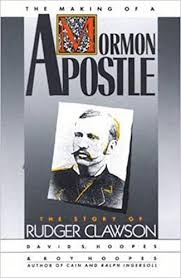Articles/Essays – Volume 24, No. 3
Clawson and the Mormon Experience | David S. Hoopes and Ray Hoopes, The Making of a Mormon Apostle: The Story of Rudger Clawson
In 1879 a young Mormon missionary named Rudger Clawson watched as an anti-Mormon mob in Georgia killed his companion. Through bluff and bravado Clawson survived the assault and brought his companion’s body back to church and family in Utah. The murdered Joseph Standing became another in a long line of Mormon martyrs, while Clawson received a hero’s welcome and lived with that distinction his entire life. In this dramatically written biography, journalists David and Roy Hoopes trace their grandfather’s early life and emergence as an apostle against the backdrop of the Mormon experience.
Rudger Clawson (1857-1943) was the son of Hiram B. Clawson, friend and son in-law to Brigham Young and manager of Young’s personal estate, and Margaret Judd, the second of Hiram’s four wives. Raised near the heart of the Church and schooled in shorthand and accounting, Rudger worked for John Young and for ZCMI before his mission and rendezvous with fame.
Following his mission, Clawson entered into polygamy despite warning clouds building on the national horizon. In 1882 he married Florence Dinwoody for status and to please his mother; seven months later he married Lydia Spencer, a poor, semi-literate but attractive woman, for love. Never particularly subtle in keeping his polygamous relationship secret, Clawson became one of the first prosecuted and convicted under the Edmunds Act of 1882. He received the maximum sentence and served over three years in the state penitentiary. Florence divorced him while he was in prison, but Lydia stood by him as she would years later when he took another younger wife.
While in prison, Clawson met and became friends with apostle Lorenzo Snow, who was impressed with Clawson’s bookkeeping and teaching abilities. After Clawson’s release, Snow took charge of the young man’s Church career, appointing him president of the Box Elder Stake —Snow’s old domain. When Snow became Church President in 1898, he ordained the forty-one-year-old Clawson as an apostle, and three days before his death in 1901 he called Clawson to the First Presidency as second counselor.
Such illumination of the internal dynamics of the Church hierarchy and the issue of advancement and succession is perhaps the book’s most interesting contribution. There is little doubt that Clawson advanced as Snow’s personal protege. Snow brought Clawson into the Council at a crucial period of fiscal stress and insolvency following the Edmunds Tucker Act. Clawson’s ordination, his bookkeeping abilities, and Snow’s campaign to collect a full tithe from Church members form a calculated strategy (prophetic or otherwise) to control and solve the problems of Church indebtedness. Clawson was, in fact, more bookkeeper than apostle for several years, drawing an accountant’s wage and overseeing until 1910 the closing of Church accounts. By rights Clawson should have remained in the First Presidency when President Snow died, but Joseph F. Smith broke with tradition and chose two new counselors. Smith created his own hierarchy and pro moted his own proteges, including a twenty-nine-year-old son whom he ordained an apostle. Here then is a tantalizing glimpse of internal Church politics, but only a glimpse.
Clawson’s life as an apostle is equally revealing of the practice of and attitudes toward post-Manifesto polygamy. As the Reed Smoot affair raged nationally and after Joseph F. Smith had presented the second manifesto in 1904, Clawson plunged into polygamy again, marrying twenty-three-year-old Pearl Udall of St. Johns, Arizona. Although Joseph F. Smith and many other apostles secretly approved of polygamy, publicly they disavowed knowledge of its practice. Clawson and the other members of the quorum sat in judgment of fellow apostles John W. Taylor and Matthias Cowley (who con ducted Clawson’s last marriage) and ap proved their excommunication. Clawson later served from 1910 to 1913 as president of the European Mission, headquartered in Liverpool. There he continued to deny and condemn the charge of polygamy, even as his own clandestine union with Pearl began to collapse. Between 19 and 1943 Clawson remained an active apostle and at the time of his death was next in line for the Church presidency.
Clawson was a twentieth-century Mormon apostle. But this biography offers relatively little twentieth-century information about him or his church. In part this is the fault of the authors and in part symptomatic of Mormon history. Hoopes and Hoopes are tied to the documentary evidence they possess—Clawson’s letters and extensive diaries. When these sources dry up in 1913, so does the authors’ analysis of Clawson’s life. The authors treat the last thirty years as “epilogue” to the nineteenth-century man—an unfortunate way to sum up the last third of a man’s life. Other sources are surely available to fill in this and other gaps in their historical record, but as the authors note, most are inaccessible, given the restrictions the Church places on use of its archival holdings. I suppose we should be thankful that Clawson and his descendants had the fore sight to withhold his journals from that black hole. Unfortunately contemporary Mormon history will remain safely nineteenth century, beyond scholarly scrutiny, awaiting the creation and approval of internally generated “truths” of the twentieth century.
Hoopes and Hoopes have created a very engaging biography that reads like a historical novel, complete with dialogue. They understand dramatic effect and have a flair for the colorful. Historians, however, will be uncomfortable with parts of that narrative. The bizarre style used to document quotations and sources and the numerous errors resulting from sloppy copy-editing will compound these fears. Despite its limitations, this book deserves a wide readership and careful consideration for the picture it paints—at once loving and critical—of one apostle, polygamy, and Mormon leadership.
The Making of a Mormon Apostle: The Story of Rudger Clawson by David S. Hoopes and Roy Hoopes (Lanham, Maryland: Madison Books, 1990), illustrations, notes, bibliography, index, xvii, 330 pp., $24.95.


 Back to full Issue
Back to full Issue

